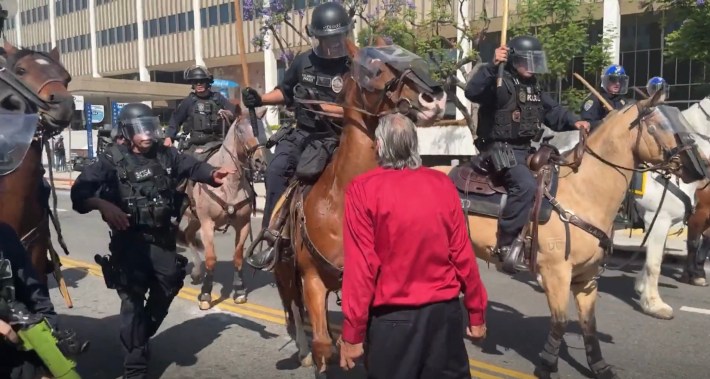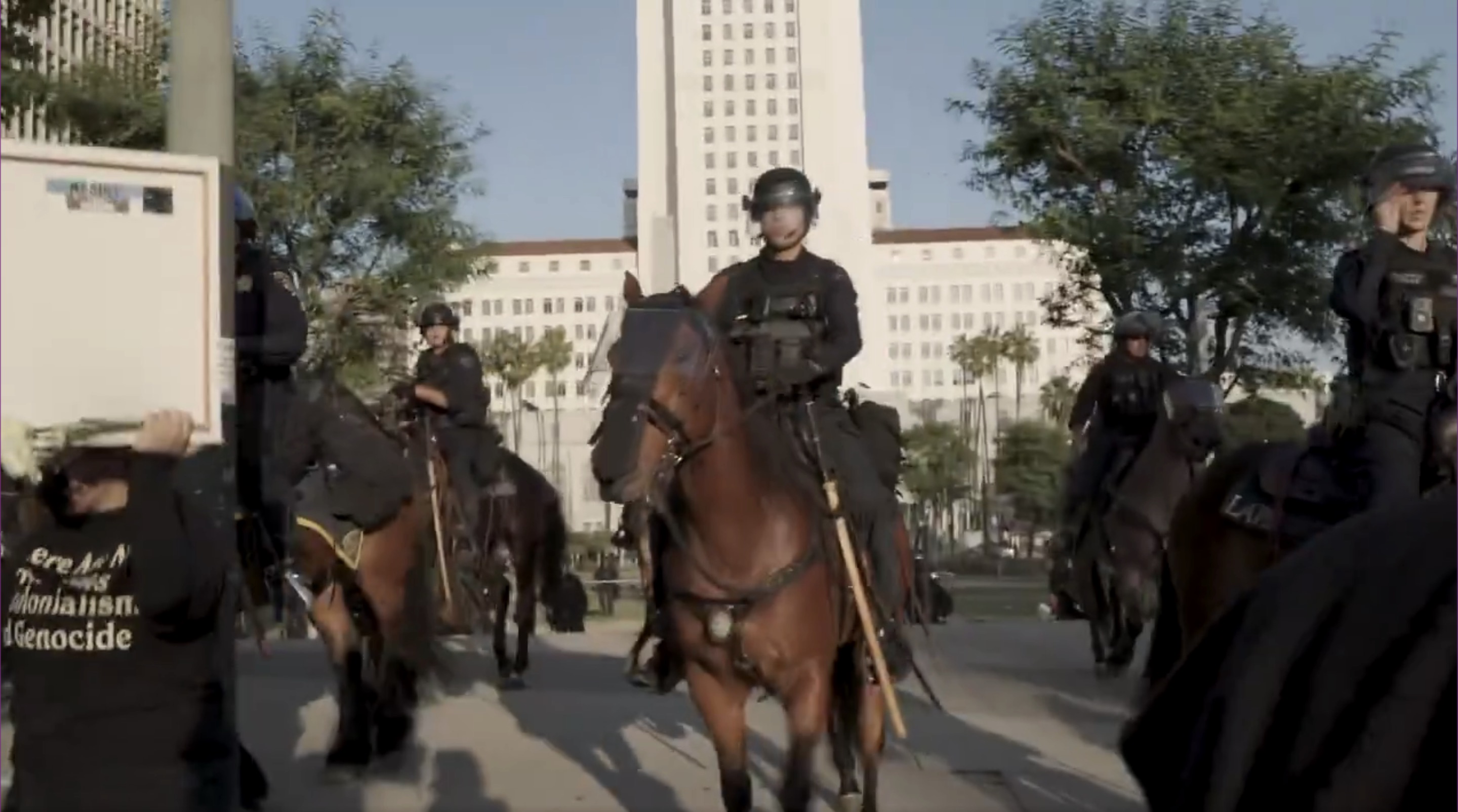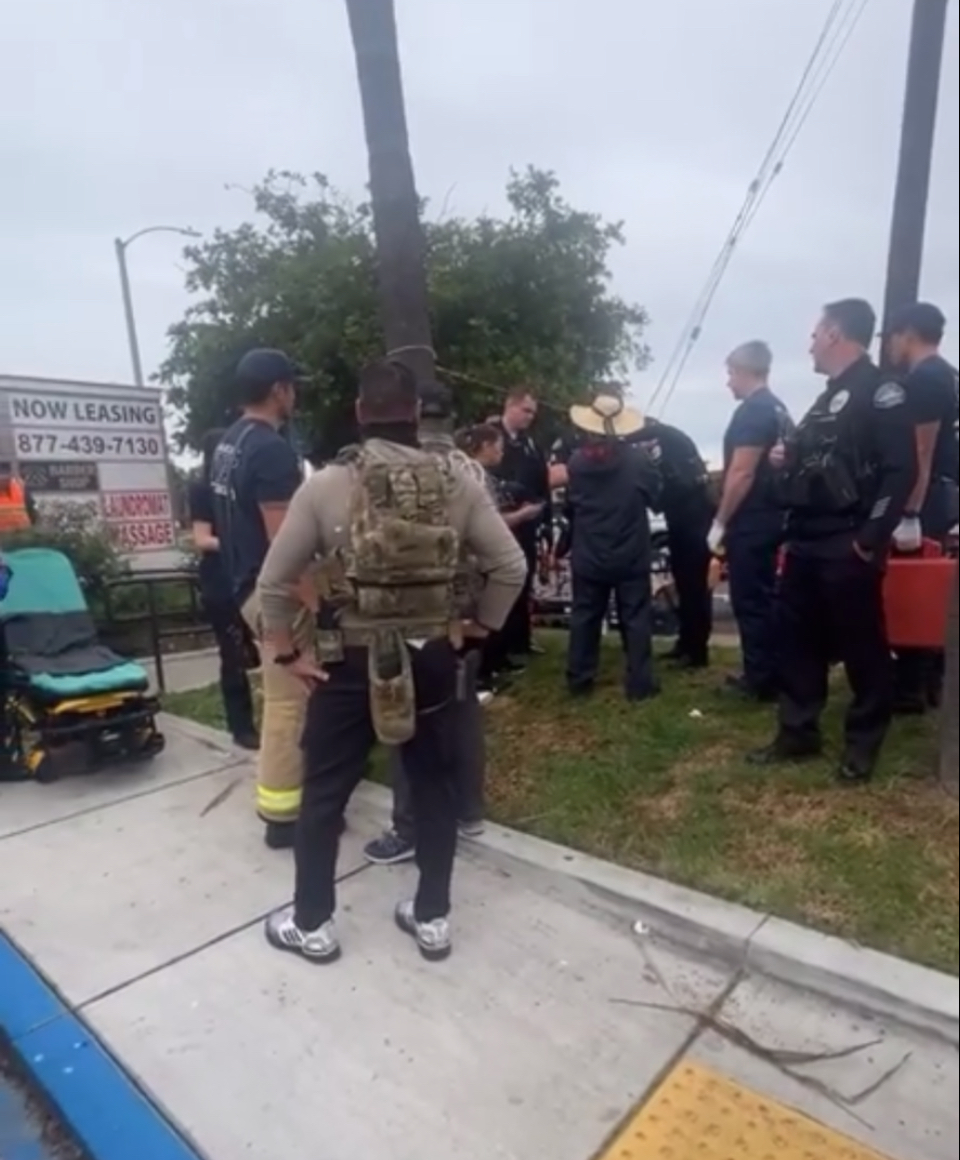As the ongoing demonstrations against ICE raids continue, the Los Angeles Police Department (LAPD)’s use of police horses for crowd control is being called into question.
Over the past two weeks alone, dozens of videos have been shared of mounted officers on horseback trampling protesters and riding horses through fireworks and clouds of tear gas.
On June 8th, the Los Angeles-based account Hear In LA shared a video of multiple law enforcement officers on horseback repeatedly trampling an unknown person. Seconds into the video, what appears to be fireworks are set off in the direction of the mounted officers and the unidentified person who was trampled.
In response, one X user posted, “Trampled by two horses and [whacked] with a baton all while lying on the ground unarmed.”
Based on the video clip alone, it’s unclear what events led up to the incident, but the presence of officers on horseback in the midst of explosives raises major concerns about the safety of protesters, as well as the well-being of the animals.

In a separate incident, Arturo Obrego, a 77-year-old army veteran present at Saturday’s No Kings protest in DTLA, was assaulted by an LAPD officer on horseback who was armed with a wooden baton.
“The rider on the horse knocked me down five times with his horse,” Obrego told L.A. TACO in an interview. “It busted my f-cking back.”
In response to the video shared on L.A. TACO’s TikTok, several commenters called LAPD mounted units into question. One top comment said, “LAPD mounted police need to be investigated, too many incidents of unnecessary brutality.”
Another commenter said, “It’s cruelty to the horses. Horrifying.”
Due to the fragile nature of horses’ legs, which are particularly vulnerable to life-threatening fractures, mounted officers urging their horses to step over or trample people in crowds have the potential to cause severe injuries to the people and the animals.
That same afternoon, mounted officers rode on horseback through a large crowd of protesters as law enforcement deployed tear gas and flash bangs.
Horses aren’t typically as sensitive to the effects of tear gas (burning eyes, temporary blindness, respiratory distress) as humans, but they can be harmed by flash bangs, which create a loud explosion and flash of light.
Constructed like a grenade, flash bangs can cause temporary or permanent hearing loss and temporary blindness, as well as blunt and penetrating trauma from shrapnel.
At the No Kings protest last Saturday, a 33-year-old man lost his finger after he was reportedly struck by a flash bang device thrown by a Los Angeles County Sheriff.
A pretty shocking clip from today. An LAPD officer on horseback tramples a protester who then falls in front of another horse. As others try to help the protester up, an LAPD officer wields a blunt weapon to strike the protester, but strikes a nearby horse in the head. pic.twitter.com/pBEuBcTyzV
— Jeremy Lindenfeld (@jeremotographs) June 12, 2025
Last week, Capitol & Main reporter Jeremy Lindenfeld also shared video of an LAPD officer striking a nearby police horse with a baton. In the video clip, it appears that the officer is aiming for a person protesting against ICE and instead accidentally strikes another officer’s horse.
The recent ongoing protests are not the first time law enforcement’s deployment of police horses have raised alarm bells.
Just last year, the family of a teenager who received a head injury from a police horse filed a lawsuit for $1 million in damages. After a Dallas Police Department horse was startled at the State Fair of Texas, it threw off the mounted officer who was riding it and knocked a 17-year-old boy to the ground. The teenage victim was knocked unconscious and had a seizure. The police officer was reportedly also injured.
In January 2021, the day of former President Biden’s inauguration, Los Angeles Times reported on LAPD’s use of horses in the middle of a dense crowd of protesters. According to three witnesses, mounted officers quickly formed a line and shouted “move” with “little to no warning.” Though no life-threatening injuries were reported, several protesters were stomped on by LAPD horses.
Carol Sobel, a prominent civil rights attorney, told the Times, “This is not a SWAT situation, this is not a hostage situation, this is not an armed person. The police need to figure out how you de-escalate that. You don’t de-escalate by bringing in large horses.”
Sobel blamed the incident on a lack of police training and planning. Despite the dangers to both animals and humans, LAPD’s Mounted Platoon officers are required to receive only four weeks of equestrian training, as well as an additional week out in the field.
In a safety manual designed for law enforcement, the United Nations makes it clear that police horses should never be used to trample peaceful crowds of protesters.
“Horses can be used to charge a group of violent people and disperse them … but the horse is not meant to ride over people, as that can obviously be extremely dangerous.”
The Office for Democratic Institutions and Human Rights (ODIHR) also raises serious safety concerns about the deployment of animals by police in crowd control situations.
Due to the unpredictable nature of animals — even police animals that have been trained to navigate high-stress environments — mounted officers do not have complete control over their horses’ reactions, which creates a greater risk of serious physical harm to crowds, officers, and the horses themselves.
“There is a risk of serious bodily injury or death if horses are deployed in inappropriate circumstances, and their mere presence could unnecessarily escalate tensions. If an officer becomes unseated, the horse may react even more unpredictably and cause serious or life threatening injuries.”







